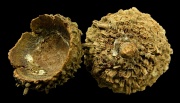Difference between revisions of "Acorn"
Jump to navigation
Jump to search
(username removed) |
(username removed) |
||
| Line 2: | Line 2: | ||
== Description == | == Description == | ||
| − | A natural brown dye can be extracted from acorns similar to dyes obtained from [http://cameo.mfa.org/materials/fullrecord.asp?name=oak | + | A natural brown dye can be extracted from acorns similar to dyes obtained from [http://cameo.mfa.org/materials/fullrecord.asp?name=oak%20bark oak bark]. |
See [http://cameo.mfa.org/materials/fullrecord.asp?name=quercitron quercitron]. | See [http://cameo.mfa.org/materials/fullrecord.asp?name=quercitron quercitron]. | ||
| Line 12: | Line 12: | ||
== Authority == | == Authority == | ||
| − | * | + | * R.J. Adrosko, ''Natural Dyes in the United States'', Smithsonian Institution Press, Washington, DC, 1968 |
[[Category:Materials database]] | [[Category:Materials database]] | ||
Revision as of 06:56, 24 July 2013
Description
A natural brown dye can be extracted from acorns similar to dyes obtained from oak bark.
See quercitron.
Synonyms and Related Terms
ghianda (It.), tsurubami (Jap.), kunugi (Jap.)
Authority
- R.J. Adrosko, Natural Dyes in the United States, Smithsonian Institution Press, Washington, DC, 1968
